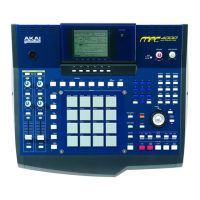Trim/Loop page
175
The new sample will be recorded, and the Keep or Retry window will appear.
A New name field
Allows you to edit the name of the sample.
B [F1] key (RETRY)
Discards the edited result, and returns to the previous page.
C [F2] key (OVER WR)
Overwrites the edited result onto the original sample in memory.
D [F3] key (P
®
NEW)
Plays the edited sample.
E [F4] key (P
®
ORIGIN)
Plays the original (unedited) sample.
F [F5] key (ADD PGM)
Opens the Add to Program popup window, where you can add the edited sample to a pro-
gram.
G [F6] key (KEEP)
Retains the edited sample in memory.
5. Use the [F3] key (P
®
NEW) and [F4] key (P
®
ORIGIN) to compare the edited and
original samples.
6. If you are satisfied with the resampled result, assign a new name to the sample
as necessary, and press either the [F2] key, [F5] key, or [F6] key to save the new
sample.
Note: If you press the [F2] key (OVER WR), the new sample name will be ignored, and the edited sample
will be overwritten onto the original sample.
1
2 3 4 5 6 7

